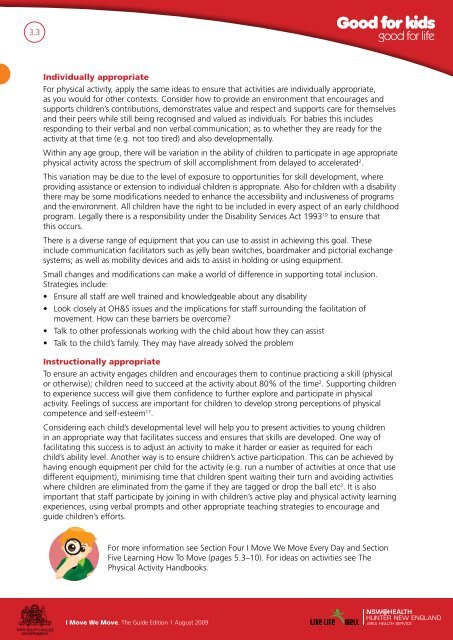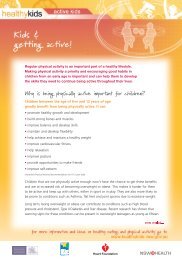I Move We Move - Good For Kids - NSW Government
I Move We Move - Good For Kids - NSW Government
I Move We Move - Good For Kids - NSW Government
You also want an ePaper? Increase the reach of your titles
YUMPU automatically turns print PDFs into web optimized ePapers that Google loves.
3.3<br />
Individually appropriate<br />
<strong>For</strong> physical activity, apply the same ideas to ensure that activities are individually appropriate,<br />
as you would for other contexts. Consider how to provide an environment that encourages and<br />
supports children’s contributions, demonstrates value and respect and supports care for themselves<br />
and their peers while still being recognised and valued as individuals. <strong>For</strong> babies this includes<br />
responding to their verbal and non verbal communication; as to whether they are ready for the<br />
activity at that time (e.g. not too tired) and also developmentally.<br />
Within any age group, there will be variation in the ability of children to participate in age appropriate<br />
physical activity across the spectrum of skill accomplishment from delayed to accelerated2 .<br />
This variation may be due to the level of exposure to opportunities for skill development, where<br />
providing assistance or extension to individual children is appropriate. Also for children with a disability<br />
there may be some modifications needed to enhance the accessibility and inclusiveness of programs<br />
and the environment. All children have the right to be included in every aspect of an early childhood<br />
program. Legally there is a responsibility under the Disability Services Act 199319 to ensure that<br />
this occurs.<br />
There is a diverse range of equipment that you can use to assist in achieving this goal. These<br />
include communication facilitators such as jelly bean switches, boardmaker and pictorial exchange<br />
systems; as well as mobility devices and aids to assist in holding or using equipment.<br />
Small changes and modifications can make a world of difference in supporting total inclusion.<br />
Strategies include:<br />
• Ensure all staff are well trained and knowledgeable about any disability<br />
• Look closely at OH&S issues and the implications for staff surrounding the facilitation of<br />
movement. How can these barriers be overcome?<br />
• Talk to other professionals working with the child about how they can assist<br />
• Talk to the child’s family. They may have already solved the problem<br />
Instructionally appropriate<br />
To ensure an activity engages children and encourages them to continue practicing a skill (physical<br />
or otherwise); children need to succeed at the activity about 80% of the time 2 . Supporting children<br />
to experience success will give them confidence to further explore and participate in physical<br />
activity. Feelings of success are important for children to develop strong perceptions of physical<br />
competence and self-esteem 17 .<br />
Considering each child’s developmental level will help you to present activities to young children<br />
in an appropriate way that facilitates success and ensures that skills are developed. One way of<br />
facilitating this success is to adjust an activity to make it harder or easier as required for each<br />
child’s ability level. Another way is to ensure children’s active participation. This can be achieved by<br />
having enough equipment per child for the activity (e.g. run a number of activities at once that use<br />
different equipment), minimising time that children spent waiting their turn and avoiding activities<br />
where children are eliminated from the game if they are tagged or drop the ball etc 2 . It is also<br />
important that staff participate by joining in with children’s active play and physical activity learning<br />
experiences, using verbal prompts and other appropriate teaching strategies to encourage and<br />
guide children’s efforts.<br />
<strong>For</strong> more information see Section Four I <strong>Move</strong> <strong>We</strong> <strong>Move</strong> Every Day and Section<br />
Five Learning How To <strong>Move</strong> (pages 5.3–10). <strong>For</strong> ideas on activities see The<br />
Physical Activity Handbooks.<br />
I <strong>Move</strong> <strong>We</strong> <strong>Move</strong>, The Guide Edition 1 August 2009<br />
AREA HEALTH SERVICE




